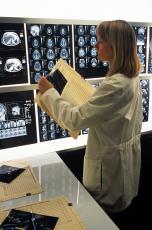National Institutes of Health
- The primary NIH organization for research on Diagnostic Imaging is the National Institute of Biomedical Engineering and Bioimaging
 A service of the U.S. National Library of Medicine
A service of the U.S. National Library of Medicine  National Institutes of Health
National Institutes of Health
Diagnostic imaging refers to technologies that doctors use to look inside your body for clues about a medical condition. A variety of machines and techniques can create pictures of the structures and activities inside your body. The technology your doctor uses will depend on your symptoms and the part of your body being examined. X-rays, CT scans, nuclear medicine scans, MRI scans and ultrasound are all types of diagnostic imaging.
Many imaging tests are painless and easy. Some require you to stay still for a long time inside a machine, though. This can be uncomfortable. Certain tests involve radiation, but these are generally considered safe because the dosage is very low.
For some imaging tests, a tiny camera attached to a long, thin tube is inserted in your body. This tool is called a scope. The doctor moves it through a body passageway or opening to see inside a particular organ, such as your heart, lungs or colon. These procedures often require anesthesia.
References and abstracts from MEDLINE/PubMed (National Library of Medicine)
